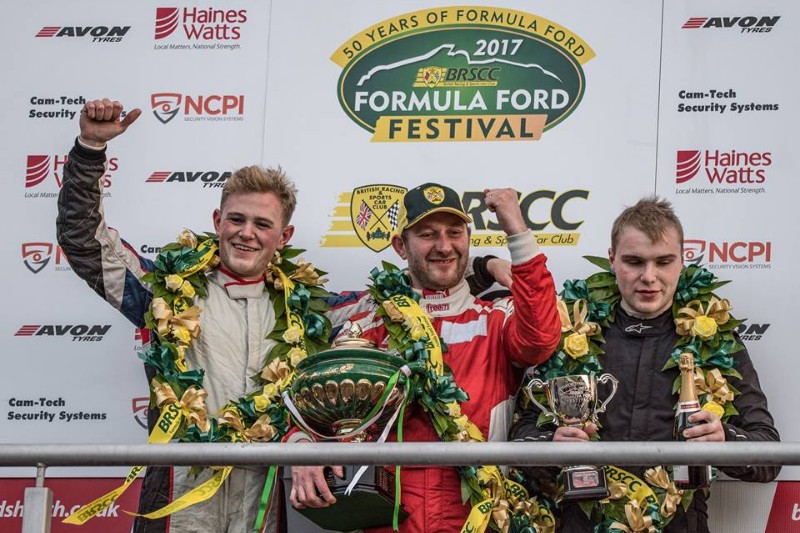
Photo: Facebook.com/TheBlackStuff.net
Although his results speak volumes – a Formula 3 title, six Formula Ford Festival and Walter Hayes Trophy wins, including the legendary 2005 washout in the latter – it’s only when you hear Joey Foster’s story do you realise how talented he is.
“As young as I can remember I always wanted to be an F1 driver. There was nothing else in my life,” the 36-year-old tells Formula Scout.
“There was no racing history in our family. My parents moved from London to Cornwall when I was three, and I just kept going on at them saying: ‘I?m starting karting, because all F1 drivers start in karting’. They’d respond: ‘shut up, you’ll forget about it in a couple of years’. But I didn’t. They bought me a grass kart and I started bombing around the fields, which kept me busy for a few years.
“Eventually a kart track opened in Camborne. I went there twice a week and I think the parents realised the bug wasn’t going to go away so they got me a karting day at Silverstone. And a lad there took us under his wing really; sold us a kart to race at the outdoor venues. So we raced the South West champs, then me and my dad went to the Champions of the Future [CotF] level in Formula Yamaha. From 1994 to ’99 I was karting.”
In FYamaha he raced against Lewis Hamilton, Paul di Resta and Oliver Jarvis, the latter whom beat Foster to the 2005 McLaren Autosport BRDC Award.
“We ran [Martin Hines’] Zip karts in Formula Yamaha, but obviously they had their works team and we were just father and son. I remember the first time we turned up to a CotF meeting we had a Volvo estate, with the kart on the roof.
“We turned up at Buckmore Park in middle of the night, and slept in the Volvo, and two motorhomes pulled up either side of us. ‘What have we got ourselves into?’. We were up against top teams, [Mike] Conway, Jarvis, all those guys. Looking back, we did bloody well, but at the time I was really disappointed because we were finishing seventh, eighth, ninth out of 33. Looking back we did a really good job because at the time, Dad didn’t even know the difference between a two and four-stroke.”
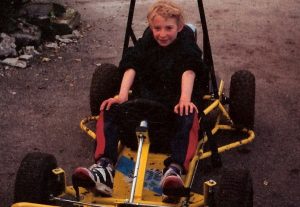
It wasn’t just the small setup that restricted Foster’s success in karting:?“I was a tall kid because I started quite late. Hamilton was 12 when he entered FYamaha, I was 15.
“At the end of 1999, Dad paid for a three day course at Jim Russell’s car racing school at Silverstone.?Halfway through, the guy running it said: ‘The Jim Russell World Scholarship Finals coming to Silverstone this weekend. We want to take two from this course to join the Finals’. It bought all the racing schools together for a shootout, with the?winner getting a free Formula Vauxhall drive.
“I got picked for the Finals, and they said ‘Don’t expect to get anywhere, these guys have raced all year. Just go and have fun’. So I had a right laugh day one – putting everything I’d learned into practice. We were sat in the race centre, and they announced the 12 finalists. And my name was called. ‘Bloody hell, Dad, don’t pick me up. I’m staying here another day!'”
“I was cycling into the track from a bed & breakfast as I wasn’t old enough to drive. Day two?they had another shootout.?They picked the last six and I was called again for another shootout on the final day. We were put in the FFord Zetec we hadn’t driven before, a step up from the 1600cc Kents. I was second in the timings to Rob Huff, by a tenth or something, and they deliberated who got the drive for ages. Eventually they picked Rob, and the drive was with Don Hardman Racing.
“Don then came over and said ‘we really want you in the car too, maybe we can work out a deal’. Don being Don, he’s an honest and salt of the earth team boss, managed to make the deal work. It was a very good deal. It had to be, it was the only way we could make it work.?So it was myself and Rob in FVauxhall in 2000. That was a tough learning year for me…
“I finished second in the championship to Rob after we had a coming together at Mallory Park where he ended on his head. In 2001 we moved into British FFord Junior with Don, had a couple of podiums, but won the winter series at the end of the year when both championships came together. In 2002, two podiums in the main championship, then?in 2003 I switched to Continental Racing. I was second in the standings and won the Festival and Walter Hayes.”
These two victories proved Foster’s quality, but a move to Formula Renault 2.0 UK in 2004 ran him dry, despite the BRDC helping with funds. As Foster describes, “they couldn’t put enough in to keep the budget going…”
Sponsorship from a local building company allowed Foster to continue racing in 2005. A return to FFord was the result, this time in USF2000. Jay Howard beat Foster to the title, and progressed all the way to IndyCar.
“That was a mad battle all year basically. I don’t know how many times we came together in that series.?At the end of 2005, I was a MABA finalist, and won the Walter Hayes three times in a row. But the funding just dried up, it was gone.”
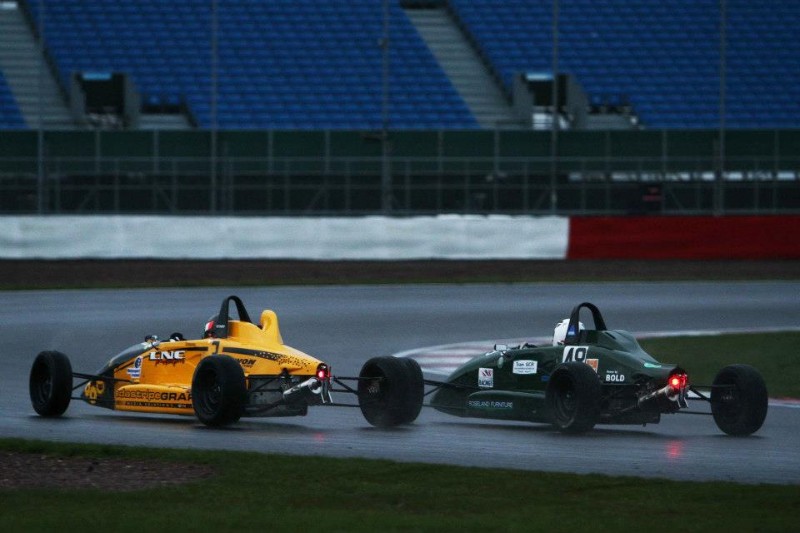
That year’s Walter Hayes Trophy is in junior single-seater folklore, with Foster topping an entry list of nearly 200 to win in some of the direst weather conditions Silverstone has ever seen. Since being resurfaced last winter the circuit has suffered from drainage problems, meaning similar events may occur at this weekend’s event.
“It was absolutely lashing it down. I’ve never known wheelspinning when changing from second to third and third to fourth on Silverstone’s back straight,” Foster recalls.
“There were cars going off on the straight, left right and centre. I was glad to be out in front in that one, and we won it by a long way. The car was just so good, it was obviously with Don again.
“After that I was working in a warehouse in Cornwall; I’d be nailing wood thinking about racing,?making all the contacts I could, talking to everybody and trying to get a drive in F3. They all wanted ?100k, which I couldn’t get.”
Foster was 23, had rightly been identified as one of Britain’s best young drivers, but had already seemingly been thrown off the single-seater ladder. Judging talent on lower formulae success alone isn’t the most reliable measure though, and Foster’s career hung on getting a chance on the next rung.
“Eventually an Austrian team called HS Engineering called on the recommendation of its main engineer, and said I should drive for them. I was just grateful, but I had no money. They said they only needed ?100,000, I said: ‘that’s fine, I know it’s a very good deal, but I don’t have ?10,000. I can barely get to the tracks’. They kept calling me so I was getting frustrated, until they said they were going to run Lola cars and if would I shakedown the car at Silverstone, so I did.
“It went very well. The boss asked me to do two more days at Oschersleben. I said: ‘Yes, but I can’t pay for it”. But we went there and did two days, and then two days at the Lausitzring,?Nurburgring, and Hockenheim. I’d racked up 10 testing days without bringing money, and just praying the guy would put me in the car for the first German F3 race. And he did.

“[Nico] Hulkenberg was in it, Ho-Pin Tung – Van Amersfoort was racing in the championship. We had two races in the first Oschersleben weekend, and I’d bent the pushrod at the first corner in race one as I had caught wheels going for sixth. I returned to the pits, and my mechanic – he was a legend – changed the pushrod and I returned to track and set fastest lap.
“I was chuffed, even though the car was all over the place. In race two I managed to get up to second and was slowly catching the leader. I managed to just get the slipstream on him on the back straight, I went for a pass around the outside at the end of the straight, just desperate for the win, and touched wheels again. He went off into the wall and I did a quick 360 then straight back on the track ahead of Hulkenberg, and he pushed me across the line for victory.”
That win kept Foster in the car, and three more meant he was a close second in the standings after six rounds. It wasn’t this F3 success that marks out Foster’s talent though, for one round later his career was nearly ended on the Lausitzring oval.
“Just a misunderstanding on Turn 1. I ended up going backwards into the wall and breaking the back of my neck,” Foster summarises.
“It was a year and a half of recovery.?I managed to stand after 12 days, but it was very brief. It was like up on your feet and then … lie me down, lie me down, lie me down. My legs felt so different, they didn’t feel like my own, even though I still had all the connections, like the weight that goes through your spine was just distributed in pretty different ways.
“It was basically learning how to walk again, and it took two months before I was out of hospital. It was probably about four months before I actually was laid down and suddenly I just felt normal again. And that?d sort of come in waves over the next month or so.
“I became a lot taller because they braced my whole spine, they lifted it all apart. There’s metal covering six vertebrae, which spaced apart whilst it all healed.”
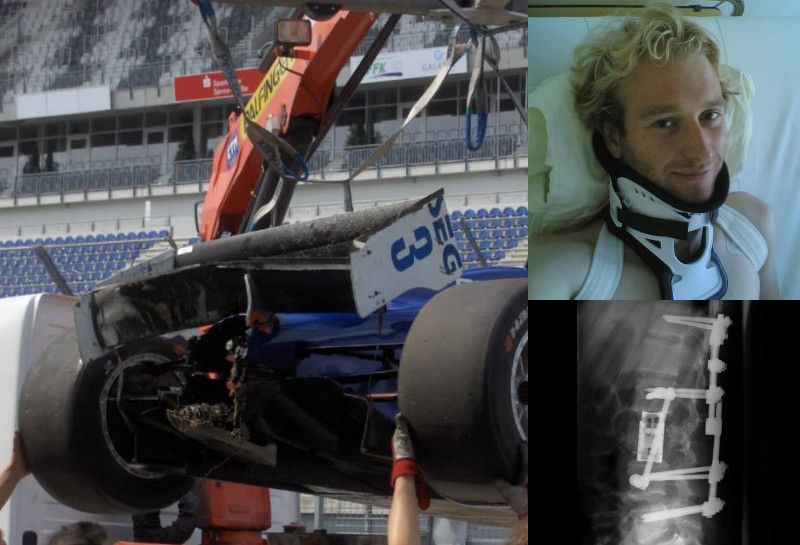
The damage from the Lausitzring crash to Foster’s car, neck and spine
As Billy Monger has had to adapt in everyday life and in racing scenarios to becoming a double amputee, Foster essentially had to accommodate what felt like a new body. Both made their single-seater returns in F3, and Foster’s success was remarkable. Relearning at an age when most drivers have mastered their craft, he also made a surprise Le Mans debut.
“It was a case of working very hard to recover, and that took over a year. HS gave me a couple races in Remus F3, and I managed to get a drive in LMP2. Jonathan France, who presented the Walter Hayes trophies in 2005, was setting up a Le Mans team, so I just kept calling and emailing. Eventually he replied, saying ‘alright, meet me in London on this day’. I went down there and he gave me the drive. So, went straight back in from nothing to having a paid LMP2 drive. I just felt like I really landed on my feet. That ended after a year, then off to Australian F3 with the sponsorship I managed to get.
“I loved Australia. I was actually thinking about going there anyway just to get away, because I realised the driving was falling to bits after the LMP2 deal. I thought it’s very hard to get a paid drive, I just need a break and hang out with some mates in Australia. I managed to get a drive out there anyway, so it worked out really well.
“It was a very last minute deal. I was back in Cornwall, working away, trying to earn a few quid. Then I got a phone call saying I’d got the drive. I flew over there, and I think the sponsor believed I was going to win the title mid-way through the year. He thought the competition was quite poor, so he wouldn’t have to pay out for the whole year.
“The championship ended up going down to the wire with [now three-time champion] Tim Macrow. Mitch Evans came in for the last round to be my team-mate [at Team BRM], and Rio Haryanto drove too, so it was a quality field.
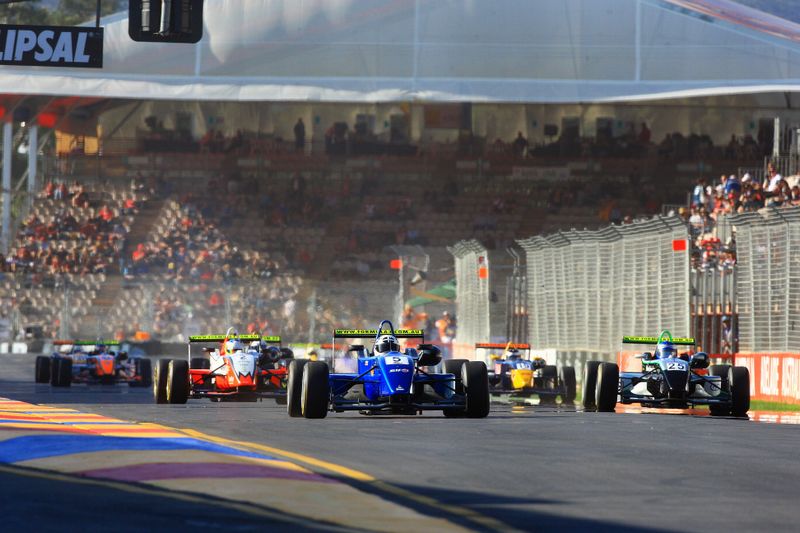
“I got a good start [in the decider], and Mitch was second and Tim was third. Basically it came down to who finished in front out of me and Tim, and Mitch started edging up on me, and I wanted him to stay behind as Tim was starting to catch me as the race went on. But we finished in front and won the championship, so it was good.”
Having run out of money twice, broken his back and come back to win a F3 title, Foster ended up on the sidelines again. He was getting older, but by no means any slower. He returned home and set up a business, ensuring he had a stable income. This allowed him to enter a few races in open-top prototypes, which he excelled at, but his run of wins was followed by another back-breaking shunt at Spa-Francorchamps.
“I jumped in the car and it felt really good. Just a little bit of understeer, coming through Eau Rouge it was flat out. I did a few more laps, and I was sledging all my braking points as it was first thing in the morning – you were pushing your braking points, seeing how far you can get. So I just came to the last chicane, what was the bus stop, hit the brakes and just chattered past the apex. And I thought: oh, ok. The braking point?s a little bit earlier than I expected, but that’s my limit.
“Same thing for La Source, just chattered past the apex, and then coming up to Eau Rouge flat-out, turned in and the thing went straight into oversteer. I caught it, it went again, hit the barriers and went over the top. The rear wing had started to fail going up the back straight, hence why the braking point wasn’t actually as early as it ended up – it was just I had no rear downforce. Next time I know, it?s flat out in Eau Rouge. The only bone I didn’t break in the German crash I broke in this one.”

The recovery was faster, but it meant Foster was once again out of racing. He concentrated on his business, got married, and started driver coaching for BRDC British F3 team Lanan Racing. The likes of George Russell, Jake Hughes and Arjun Maini made successful transitions from karts to cars thanks to Foster’s input, and although he won in a full season with Lanan in British GT4, it was single-seaters that was still lighting Foster’s fire.
A return to Australian F3 is still a desire for Foster, but for now he’s settled, in his mid-30s, back in Formula Ford 1600 with DHR. He’s added another Festival win, thanks to an incredible overtake for the lead, and is outpacing drivers half his age. This weekend he may add a record fourth Walter Hayes victory.
“What I love about FFord is the fact that the cars can be developed. You can change the chassis, the suspension, you can play around. And obviously I love the fact that it’s relatively affordable as well, so I can jump in. I had my first car race with Don and Keith [Bodicoat] all those years ago; they’re like family to me. We can enjoy ourselves, and hopefully win some races. But it has definitely got tougher this year.”
Foster returned full-time to the British championship this year, and started the year with victory from pole at Silverstone. He was second twice at Brands Hatch, then had engine issues mid-season. He took a second win at Oulton Park, and ended fifth in the standings. It was less than the title Foster desired, and he entered this year’s Festival in a Firman chassis rather than his usual Ray just for the challenge. He adapted quickly, a rarity for drivers new to Firmans, and was unlucky not to be in victory contention in the final.
American team-mate Carter Williams, who Formula Scout picked out in a recent feature, has been “pushing” Foster on to new heights, and the quality of racing and drivers in Foster’s favoured event makes it no surprise that World Endurance Championship, Formula 2 and British F3 stars have entered or been close to competing in the Walter Hayes in recent years.
Although he’s not racing in F1 like old karting rival Hamilton, there are very few drivers who are achieving success in single-seaters at his age, let alone carrying the side-effects of having broken their back twice.
“Nothings feeled like it’s changed with age, I feel like I still know how to do it. And when I’m coaching as well, I can watch the onboard videos from Arjun and George and whoever, and I can feel it. I can feel what they’re feeling. And I know where the time?s lost and found.?I drove the BRDC F3 car at Pembrey a few years ago, about 20 laps or so. I wasn’t too far off, and I had a set of old tyres on, so I’d like to think I could jump in and be up there.”